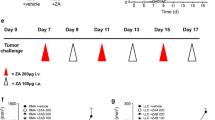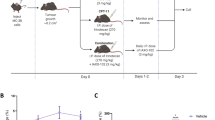Abstract
In this study the efficacy of treatment of two cyclo-oxygenase inhibitors, ibuprofen (Ibu) and indomethacin (Indo), are compared in the immunotherapy of metastasis designed to reverse prostaglandin E2 (PGE2)mediated inactivation of interleukin-2 (IL-2)-dependent host killer cell lineages. These agents were tested either alone for the prevention of metastasis or in combination with IL-2 for the eradication of established metastasis. C3H/HeN mice were placed on chronic oral Ibu (CIbT; 200 and 600 ,μg/ml of water) or Indo (CIT; 10 μg/ml) 5 days after s.c. transplantation of 5 × 105 metastatic C3L5 mammary carcinoma for the prevention of spontaneous lung metastases. They showed intolerance to Indo at a dosage of 14 μg/ml, which was well tolerated by other mouse strains in previous studies, but tolerated the Ibu dosages used. Control and treated mice were killed on day 30 to score metastatic lung colonies, to evaluate killer activity in splenocytes against natural killer (NK)-sensitive YAC-1 lymphoma or NK-resistant C3L5 adenocarcinoma and 8911 lymphoma targets, and to phenotype the surface markers of killer cells. CIbT and CIT alone at the above dosage significantly reduced the number of lung colonies, retarded local tumor growth and restored NK activity of splenic killer cells expressing AGM-1+, Thy-1−, Lyt-2− phenotype. To treat established lung metastasis, mice bearing 15-day C3L5 transplants were given CIbT or CIT alone or in combination with two 4-day rounds (days 20–23, 31–34) of IL-2 (15 000 Cetus units, i.p. every 8 h) and were killed on day 35 to score lung colonies and characterize splenic killer cells. CIbT or CIT alone reduced the number of spontaneous lung metastases and restored anti-YAC-1 killer function of splenocytes with NK-like phenotype (AGM-1+, Thy-1−, Lyt-2−); some anti-C3L5 killer function was also generated in the high dose Ibu group and the killer cell showed AGM-1+, Thy-1+ and Lyt-2+ phenotype. Combined therapies with CIbT or CIT plus IL-2 were more effective in reducing metastases and promoting killer cell function, the best results being achieved with high dose Ibu + IL-2. All killer cells expressed AGM-1 and Thy-1. In addition, C3L5 killer cells also expressed Lyt-2, suggesting T-cell stimulation. PGE2 synthesis in the host was inhibited by at least 50% in mice subjected to CIbT or CIT. Thus, Ibu proved to be an excellent substitute for Indo in preventing metastasis and NK cell activation when given alone, and also in ameliorating established metastasis and activating lymphokine-activated killer cells when combined with IL-2.
Similar content being viewed by others
References
Hanna, N. Review of evidence for role of NK cells in immunoprophylaxis of metastasis. In: Herberman, RB, Wiltrout, RH and Gorelik, E, eds. Immune Responses to Metastases, Vol. II, pp. 13–23. Boca Raton, FL: CRC Press, 1987.
Hanna, N. Role of natural killer cells in host defense against cancer metastasis. In: Nicolson, GL and Milas L, eds. Cancer Invasion and Metastasis: biologic and therapeutic aspects, pp. 309–319. New York: Raven Press, 1984.
Fidler, IJ. The generation of tumoricidal activity in macrophages for the treatment of established metastases. In: Nicolson, GL and Milas, L, eds. Cancer Invasion and Metastasis: biologic and therapeutic aspects, pp. 421–435. New York: Raven Press, 1984.
Lafreniere, R and Rosenberg, SA, 1985, Successful immunotherapy of murine experimental hepatic metastases with lymphokine-activated killer cells and recombinant Interleukin-2. Cancer Research, 45, 3735–3741.
Rosenberg, SA, Mule, JJ, Spiess, PJ, Reichert, CM and Schwarz, SL, 1985, Regression of established pulmonary metastases and subcutaneous tumor mediated by the systemic administration of high-dose recombinant Interleukin-2. Journal of Experimental Medicine, 161, 1169–1188.
Rolland, PH, Martin, PM, Jacquemier, J, Rolland, AM and Toga, M, 1980, Prostaglandin in human breast cancer: evidence suggesting an elevated prostaglan din production is a marker of high metastatic potential for neoplastic cells. Journal of the National Cancer Institute, 64, 1061–1070.
Horn, KV, Bockman, RS and Marnett, LJ, 1981, Prostaglandin and cancer: a review of tumor initiation through tumor metastasis. Prostaglandins, 21, 833–864.
Fulton, AM, 1988, The role of eicosanoids in tumor metastasis. Prostaglandins, Leukotrienes and Essential Fatty Acids, 34, 229–237.
Goodwin, JS and Ceuppens, J, 1983, Regulation of the immune response by prostaglandins. Journal of Clinical Immunology, 3, 295–315.
Lala, PK and McKenzie, IFC, 1982, An analysis of T lymphocyte subsets in tumor-transplanted mice on the basis of Lyt antigenic markers and functions. Immunology, 47, 663–677
Pope, BL, 1985, Activation of suppressor T cells by low-molecular-weight factors secreted by spleen cells from tumor-bearing mice. Cellular Immunology, 93, 364–374.
Lala, PK, PGE2 mediated inactivation of potentially tumoricidal effector cells of the host during tumor development: relevance to metastasis and immuno therapy. In: Abraham, S, ed. Carcinogenesis and Dietary Fat, pp. 219–232. Nowell, MA: S. Martinus Nijhoff Publishers, 1989.
Parhar, RS and Lala, PK, 1985, Changes in the host killer cell population in mice during tumor development. 2. The mechanism of suppression of NK activity. Cellular Immunology, 93, 265–279.
Parhar, RS and Lala, PK, 1988, Prostaglandin E-2mediated inactivation of various killer lineage cells by tumor-bearing host macrophages. Journal of Leukocyte Biology, 44, 474–484.
Fulton, AM and Levy, JG, 1981, The induction of nonspecific T suppressor lymphocytes by Prostaglandin E1. Cellular Immunology, 59, 54–60.
Rappaport, RS and Dodge, GR, 1982, Prostaglandin E inhibits the production of human Interleukin-2. Journal of Experimental Medicine, 155, 943–948.
Parhar, RS, Yagel, S and Lala, PK, 1989, PGE2-mediated immunosuppression by first trimester human decidual cells blocks activation of maternal leukocytes in the decidua with potential anti-trophoblast activity. Cellular Immunology, 120, 61–74.
Lala, PK, Kennedy, TG and Parhar, RS, 1988, Suppression of lymphocyte alloreactivity by early gestational human decidua: 11. Characterization of the suppressor mechanisms. Cellular Immunology, 116, 411–422.
Hefeneider, SH, Conlon, PJ, Henney, CS and Gillis, S, 1983, In vivo Interleukin-2 administration augments the generation of alloreactive cytolytic T lympho cytes and resident natural killer cells. Journal of Immunology, 130, 222–227.
Pace, JL, 1988, Synergistic interactions between IFN-α and IFN-τ in priming murine macrophages for tumor cell killing. Journal of Leukocyte Biology, 44, 514–520.
Brooks, CG and Henney, CS. Interleukin-2 and the regulation of natural killer activity of cultured cell populations. In: Gillis, S and Inman, FP, eds. Con tempory Topics in Molecular Immunology, Vol. 10, pp. 63–92. New York: Plenum, 1985.
Reem, GH and Yeh, N-H, 1984, Interleukin-2 regulates expression of its receptor and synthesis of τ-Interferon by human T lymphocytes. Science, 225, 429–430.
Samuelsson, B, Granstrom, E, Green, K, Hamberg, M and Hammarstrom, S, 1975, Prostaglandins. Annual Review of Biochemistry, 44, 669–695.
Lala, PK, Parhar, RS and Singh, P, 1986, Indomethacin therapy abrogates the prostaglandin-mediated suppression of natural killer activity in tumor-bearing mice and prevents tumor metastasis. Cellular Immunology, 99, 108–118.
Nelson, JAS, Parhar, RS, Scodras, JM and Lala, PK, 1990, Down-regulation of macrophage I-A expression in tumor-bearing mice. Journal of Leukocyte Biology, 48, 394–402.
Lala, PK and Parhar, RS, 1988, Chronic indomethacin therapy combined with IL-2 cures primary mammary adenocarcinomas and their spontaneous lung metastases. Proceedings of the American Association for Cancer Research, 29, 405 (Abstract).
Parhar, RS and Lala, PK, 1987, Amelioration of B16F10 melanoma lung metastasis in mice by combination therapy with indomethacin and interleukin-2. Journal of Experimental Medicine, 165, 14–28.
Lala, PK and Parhar, RS, 1988, Cure of B16F10 melanoma lung metastasis in mice by chronic indomethacin therapy combined with repeated rounds of Interleukin 2: characteristics of killer cells generated in situ. Cancer Research, 48, 1072–1079.
Parhar RS, Chambers AF and Lala PK, 1988, A comparison of the efficacy of indomethacin, IL-2, IFN-τ on their various combinations in the treatment of experimental lung metastasis. Proceedings of the 19th International Leukocyte Culture Conference, Banff, AL, 80 (Abstract).
Lala, PK, Elkashab, M, Kerbel, RS and Parhar, RS, 1990, Cure of human melanoma lung metastases in nude mice with chronic Indomethacin therapy com bined with multiple rounds of IL-2: characteristics of killer cells generated in situ. International Journal of Immunology, 2, 1149–1158.
Parhar RS, Kerbel RS and Lala PK, 1989, Chronic indomethacin plus intermittent IL-2 therapy activates killer cells in situ and cures multi-organ human melanoma metastases in nude mice. Proceedings of the 7th International Congress of Immunology, Berlin, 759 (Abstract).
Mertens, W, Bramwell, VHC and Lala, PK, 1991, Do Indomethacin (Indo) and Ranitidine (Rant) contribute significantly to responses in advanced melanoma patients treated with high-dose Interleukin-2? Proceedings of the American Society of Clinical Oncology, 10, 209 (Abstract).
Bramwell, VHC, Mertens, WC and Lala, PK, 1991, Continuous oral indomethacin (Indo) and Ranitidine (Rant) and continuous venous infusion Interleukin-2 (IL-2) in advanced renal carcinoma. Proceedings of the American Society of Clinical Oncology, 10, 171 (Abstract).
Brodt, P, Parhar, R, Sankar, P and Lala, PK, 1985, Studies on clonal heterogeneity in two spontaneously metastasizing mammary carcinomas of recent origin. International Journal of Cancer, 35, 265–273.
Mueller, RE, Ball, JK and Chan, FPH, 1989, Characterization of cell markers in type B retroviral-induced thymic lymphomas: II. Surface antigen phenotype, karyotype and proviral integration pattern in cultured lymphoma cells and cloned lines. Leukemia Research, 13, 561–571.
Boardman, PL and Hart, DF, 1967, Side effects of Indomethacin. Annals of the Rheumatic Diseases, 26, 127–132.
Fulton, AM and Levy, JG, 1980, Inhibition of murine tumor growth and prostaglandin synthesis by indomethacin. International Journal of Cancer, 26, 669–673.
Lynch, NR, Castes, M, Astoin, M and Salomon, JC, 1978, Mechanism of inhibition of tumor growth by aspirin and Indomethacin. British Journal of Cancer, 38, 503–512.
Fulton, AM, 1987, Interactions of natural effector cells and prostaglandins in the control of metastasis. Journal of the National Cancer Institute, 78, 735–741.
Maca, RD, 1988, Inhibition of the growth of Lewis lung carcinoma by indomethacin in conventional, nude and beige mice. Journal of Biological Response Modifiers, 7, 568–580.
Young, MR and Newby, M, 1986, Enhancement of Lewis lung carcinoma cell migration by Prostaglandin E2 produced by macrophages. Cancer Research, 46, 160–164.
Young, MR, Young, ME and Wepsic, HT, 1987, Effect of prostaglandin E2-producing nonmetastatic Lewis lung carcinoma cells on the migration of prostaglandin E2-responsive metastatic Lewis lung carcinoma cells. Cancer Research, 47, 3679–3683.
Fulton, AM, Hanchin, CM and Butler, WB, 1988, Heterogeneity of Prostaglandin E2 binding in murine mammary tumor cells differing in metastatic potential. Invasion and Metastasis, 8, 17–30.
Folkman, J and Klagsbrun, M, 1987, Angiogenic factors. Science, 236, 442–447.
Farrel, CL, Megyesi, J and Del Maestro, RF, 1988, Effect of Ibuprofen on tumor growth in C6 spheroid implantation glioma model. Journal of Neurosurgery, 68, 925–930.
Shu, S, Chou, T and Rosenberg, SA, 1987, Generation from tumor-bearing mice of lymphocytes with in vivo therapeutic efficacy. Journal of Immunology, 139, 295–304.
Favrot, M, Blay, JY, Combaret, V, Negrier, S and Philip, T, 1990, Correlation between clinical response and immunological modifications induced on PBL in vivo by IL-2 therapy. Proceedings of the American Association for Cancer Research, 31, 277 (Abstract).
Author information
Authors and Affiliations
Rights and permissions
About this article
Cite this article
Khoo, N.K.S., Chan, F.P.H., Saarloos, M.N. et al. Immunotherapy of mammary adenocarcinoma metastases in C3H/HeN mice with chronic administration of cyclo-oxygenase inhibitors alone or in combination with IL-2. Clin Exp Metast 10, 239–252 (1992). https://doi.org/10.1007/BF00133559
Received:
Accepted:
Issue Date:
DOI: https://doi.org/10.1007/BF00133559




